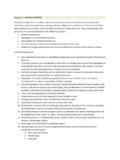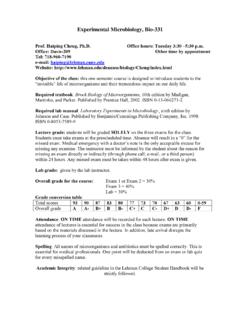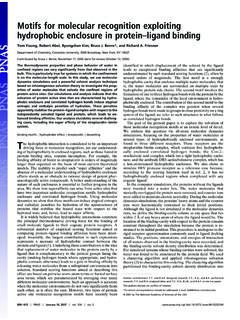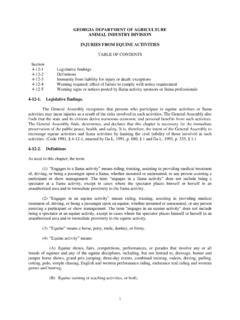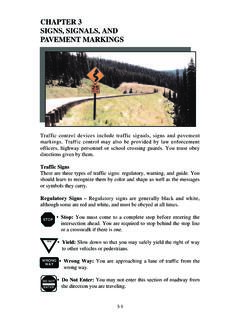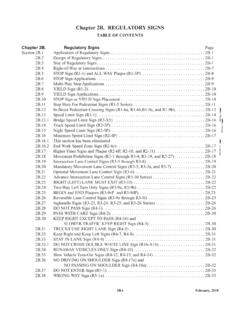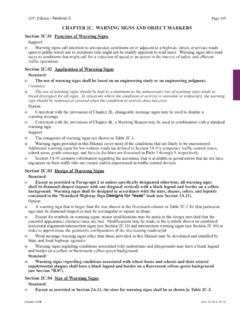Transcription of Chapter 4: HAZARD COMMUNICATION: Signs, Labels, …
1 Chapter 4: HAZARD communication : Signs, Labels, Material Safety Data Sheets, Safety Data Sheets Signs All employees must be alerted to hazards in an area. The employer shall post signs at prominent locations, informing employees they have the right to information from their employer regarding the toxic substances in the workplace. In addition, the locations of emergency equipment must be clearly marked. The CHO will be responsible for ensuring that all laboratory and storage areas follow this standard operating procedure to post signs. The following is a list of some of the most important signs that must be posted. A sign with words, LABORATORY: Potentially Hazardous Substances in RED on a white background must be posted at the entrance to each laboratory. It must be made of metal or other durable material and posted at eye level. The height of the letters in the word "Laboratory" must be at least 1 " high; lettering of "Potentially Hazardous Substances" must be at least 7/16" high.
2 Large, conspicuous signs must be posted at the location of each safety shower, eyewash station, fire extinguisher, and exit. Telephone numbers of emergency personnel, facilities, supervisors and the CHO must be posted next to the phone in each laboratory, storeroom/ stockroom and storage area. If there is no phone in the room, a sign should be posted indicating the location of the nearest phone (which should have posted next to it all the pertinent telephone numbers). All laboratories in which the following materials are used, must post signs outside the laboratory and/or chemical storage rooms indicating the presence of such hazards as: Water-reactive chemicals Carcinogens Biohazards Flammable/explosive gases Reproductive hazards Radioactive materials Inhalation hazards ( hydrogen cyanide, hydrogen sulfide) Lasers The National Fire Prevention Association (NFPA) HAZARD Rating System will be used to indicate the above hazards .
3 "Store no flammables flashing below 100OF" shall be posted on all non-explosion proof, non-flammable storage refrigerators, and cold rooms. Check with the CHO about how to properly label storage cabinets and refrigerators. Labels Chemical containers labels must be accurate, complete, and intact at all times. Hazardous chemical labels tell employees if the chemical is hazardous and the nature of the HAZARD (s). The OSHA Laboratory Standard specifically prohibits removal or defacing of labels on chemical containers. OSHA s HAZARD communication Standard (HCS) mandates that manufacturers provide properly labeled containers to users and distributors of their products. Labels must include the following information: common name of the chemical; name, address, and emergency telephone # of company responsible for the product; HAZARD warning indicating the most serious health or safety HAZARD the chemical poses ( corrosive, carcinogen, water-reactive, flammable).
4 It is common laboratory practice to transfer chemicals from their original containers to secondary containers. If the chemical remains under the control of the person who transferred it, and is used in a single work session, it is not necessary to label the secondary container. Secondary containers used by more than one person must be labeled with the information described above. This information can be found on the original label or on the material safety data sheet for the product. Warning labels must be in English, although other languages may be used in addition. Warning labels should additionally be given in other languages in settings where lab members do not speak English. The following is a description of four of the most commonly used label types: ANSI Chemical label : American National Standard Institute (ANSI) has published a voluntary labeling standard (ANSI ) followed by most chemical manufacturers containing the following items: Signal words (multiple, if necessary) to be used to indicate the severity of the HAZARD : o DANGER for the most serious HAZARD o WARNING for a moderate HAZARD o CAUTION to indicate a lesser degree of HAZARD o Toxic materials will be marked POISON Precautionary statements such as.
5 O Wash thoroughly after handling o Avoid contact with eyes, skin and clothing o Use only with adequate ventilation o Keep away from heat, sparks, and flame o Keep away from contact with clothing and other combustible materials Instructions in case of accidental exposure will be included whenever immediate action is needed. Instructions will be given in a simple fashion that assumes no special knowledge or training on the part of the responder. Examples of first aid statements are: o If inhaled, remove to fresh air o If not breathing, give artificial respiration. If breathing is difficult, give oxygen o Get medical attention immediately o In case of contact, flush eyes immediately with water for at least 15 minutes Notes to physician for emergency treatment if an antidote or special treatment Instructions in case of fire or chemical spill Instructions for chemical handling and storage NFPA Labeling System: The NFPA HAZARD diamond is a method of labeling materials to indicate the level of HAZARD they present.
6 The blue, red, and yellow colored areas indicate, respectively, the Health, Flammability, and Reactivity hazards associated with the material. These three areas use a numbered scale ranging from zero to four (zero 4: minimal, slight, moderate, serious, extreme HAZARD ). A value of zero means that the material poses essentially no HAZARD ; a rating of four indicates a high degree of HAZARD . The white area is reserved for special HAZARD warnings such as water reactivity or other HAZARD . HCS-compliant Hazardous Material Identification Guide (HMIG, below left) and the Hazardous Material Information System (HMIS, below right): HMIG is a labeling system developed and sold through Lab Safety Supply Inc. The HMIS was developed by the National Paint and Coatings Association (NPCA) and sold through Labelmaster Inc. Both systems use a label with a space at the top for the chemical name.
7 The blue, red, and orange (or yellow) colored bars indicate, respectively, the health, flammability, and reactivity HAZARD associated with the material. HMIG and HMIS use a numbered scale ranging from zero to four. A zero indicates the material is essentially nonhazardous; a rating of four indicates extreme danger. Although the details of how numbers are assigned may vary somewhat between systems, this is essentially the same overall scheme as is used in the NFPA system but note there are differences between NFPA and HMIG. The revised HMIS system (1995) includes a second box on the blue (health HAZARD ) bar. An asterisk (*) in this box indicates the chemical is associated with chronic (long-term) health effect(s). The fourth, white bar is marked "Protective Equipment" (HMIG), and "Personal Protection" (HMIS). Both systems place a letter in this bar to indicate the kind(s) of personal protective equipment (PPE) that should be used to handle the material safely.
8 Meanings of the letters are the same in both systems, and both systems supplement the letter code with icons or pictograms showing the kinds of PPE to be used: Any highly toxic substance, known/suspected carcinogen or chemicals that present significant physical hazards (flammability, reactivity etc.) must be relabeled if it is repackaged. In particular, if a solution of more than 1% of a highly toxic substance (defined as having an LD50 < 50mg/kg) or of a known/suspected carcinogen is made, it must be relabeled with information contained on the original label . These Right-to-Know (RTK) labels must contain the full name of the material, its concentration in percent, a warning section including modes of entry, target organs, handling/use precautions, and first aid. Employees are responsible for inspecting each container to ensure that it arrives properly labeled.
9 Problems with an incoming product label should be reported to a supervisor. Employees have the right to reject shipment of improperly labeled products. Any laboratory employee finding unlabeled containers, containers without the minimum of information required, or labels that are torn or illegible, must report it to their supervisor. PIs will be responsible for ensuring that newly synthesized chemicals are used exclusively within the laboratory, and are properly labeled. If its hazards are unknown, it must be assumed to be hazardous, and the label must indicate that its potential hazards have not been tested and are unknown. See Chapter 6 for the special precautions which should be taken when handling these substances. Material Safety Data Sheets (MSDS) An MSDS must be obtained for every hazardous chemical used in a workplace. Although the standard specifies the information required to be on an MSDS, it does not dictate a set format.
10 This means employers must not only acquire MSDSs, but they must review them for completeness. The OSHA-required MSDS format contains the following categories: Section I. Manufacturer's Name and Contact Information Section V. Reactivity Data Section II. Hazardous Ingredients/Identity Information Section VI. Health HAZARD Data Section III. Physical/Chemical Characteristics Section VII. Precautions for Safe Handling and Use Section IV. Fire and Explosion HAZARD Data Section VIII. Control Measures OSHA Laboratory Standard Requirements The OSHA Laboratory Standard (as well as the New York State Right-to-Know Law - for public sector laboratories) requires that MSDSs be collected and maintained for all chemicals used and stored in the laboratory. Along with chemical container labels, the HAZARD communication Standard (HCS) mandates that chemical manufacturer provide MSDSs for each chemical.
